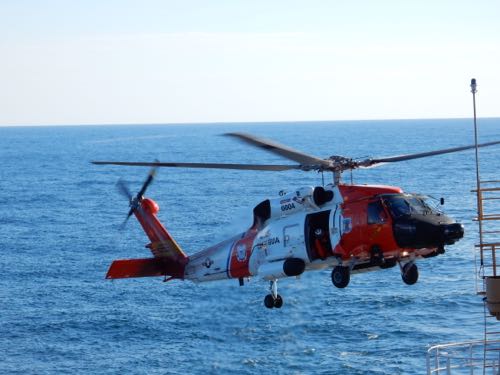Today was our first full day at sea, and even though we have not reached the research stations things have been busy. The marine mammal and bird groups have been busy watching for animals from the bridge while we transit, there were helicopter practice landings and take-offs, and we conducted "man overboard" and "abandon ship" drills. These travels also have me feeling more confident about finding my way around the ship. It was super exciting to see a minke whale breaching a few times. Unfortunately, that is one of the few times over the past few days when I did not have a camera in hand.
Coast Guard Helicopter Practice
The Coast Guard used this morning's transit time to practice helicopter skills, and I had the opportunity to watch the landings and take-offs for quite a while. Helicopter piloting skills are obviously critical as there is very little room for error when landing in a small space on a moving ship, but I was really impressed with the communication, cooperation, and the way each individual's work contributed to a successful operation. This was a great example of how the communication skills students practice during class activities are applied in real-life settings.
 Helicopter ops onboard USCGC Healy.
Helicopter ops onboard USCGC Healy.
Up Close To A Glacier
Last night it was a treat to view the Holgate Glacier from a prime vantage point. The glacier was bluish, and debris were evident in the ice. There were also small chunks of ice in the surrounding water. As I traveled from Anchorage to Seward, and then while in Seward, I noticed that the water had a "milky" appearance. When I asked about this, I learned that the "milky" waters are fed by glaciers.
 Holgate Glacier
Holgate Glacier
Challenge Q and A
What causes the glacier-fed waters to appear "milky"?
Answer to the Last Journal Q: Benthic organisms are those that live on the seafloor or in seafloor sediments while pelagic organisms are mostly in open waters higher up the water column.

